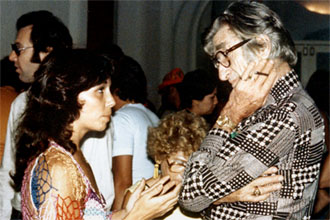|
| Magriel's NYT Columns |

Prince Alexis Obolensky (right)
speaking with Lee Genud. Two of backgammon’s best-known personalities, Prince Alexis Obolensky and Claude Beer, competed in the finals of the 1977 Annual Club El Morocco Tournament. Obolensky was the original driving force behind the current backgammon explosion.
Beer has long been one of the world’s top-ranked players. Opponents have sometimes underestimated Beer, because of his disdain for mathematical computations. But Beer, a strong positional player with a fine grasp of strategy, has an impressive series of tournament triumphs to his name. Most notably, he won the 1974 World Championship. That same year, in a match pitting the top six American players against the top six of the United Kingdom, Beer made a clean sweep, 6 to 0.
At the El Morocco tornament, Beer (Black) had fallen behind Obolensky (White) 16 to 12 in the 25-point finals match. Beer had already doubled and reached the favorable position shown in the diagram. Then he rolled a 6-3.
|
16
MATCH TO 25 12 |
| Black to play 6-3. |
Why didn’t he simply play the apparently safer move, 15/6, avoiding a direct return shot and leaving himself well ahead in the race? He recognized that both plays had merits. He also knew that there were other considerations besides immediate safety. As is often the case in backgammon, even at the highest levels, there was no clear-cut right or wrong. The best Beer could do was weigh the relavant factors.
|
|
|
Yet White’s chances in a race are not insignificant. Such racing positions are often deceptive. Note that the pip count is identical before the roll. If White gets around the board quickly, he will have a reasonable chance of winning.
With the apparently more dangerous play, 15/9, 4/1*, Black eliminates White’s chances in the race altogether. If White fails to reenter immediately with a 1, Black will have an easy victory. But even if White reenters from the bar and hits on the 1-point, Black is far from lost. White will still have to escape from behind Black’s 5-point prime with a 6. Before he escapes, Black will have an excellent chance to reenter in White’s home board and hit White again on the 1-point. Furthermore, if Black can then close White out, Black might get a valuable added bonus — a gammon.
This final consideration swayed Black (Beer) to make the hit. White (Obolensky) next rolled 6-1 — his best possible number — and played bar/1*/7, not only hitting Black but also escaping from behind Black’s prime. Beer stayed out, so Obolensky redoubled. Beer was forced to pass and fell further behind in the match, 18 to 12. Obolensky maintained his lead, winning the match 25 to 16 for the club championship.
Immediately afterward, several experts engaging in the usual post-mortem analysis questioned whether the hit on the 1-point had been justified. Even though he lost, Beer’s instinctive grasp of strategy was confirmed: A few days later, an in-depth mathematical analysis showed that his play had in fact been correct.
Rollout
 Tom Keith 2013 |
|
Match to 25 White 16, Black 12 White owns 2-cube Black rolls 6-3 1296 games with VR Checker play: 2-ply Cube play: 3-ply Red |
| 6-3: | Game | G | BG | Equity | ||||
| 1 | 15/9, 4/1* |
W L |
.8583 .1417 |
.0769 .0065 |
.0013 .0000 | +0.7554 |

| (a) |
| 2 | 15/6 |
W L |
.8726 .1274 |
.0165 .0000 |
.0003 .0000 | +0.7304 | (0.0250) | (b) |

|
|

